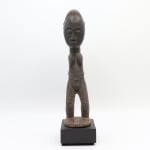Baule Female Sculpture, 19th to early 20th century CE
Wood
height 26.5 cm
height 10 3/8 in
dimensions given without mounting
height 10 3/8 in
dimensions given without mounting
LI.3420
Further images
-
(View a larger image of thumbnail 1
)

-
(View a larger image of thumbnail 2
)

-
(View a larger image of thumbnail 3
)

-
(View a larger image of thumbnail 4
)

-
(View a larger image of thumbnail 5
)

-
(View a larger image of thumbnail 6
)

-
(View a larger image of thumbnail 7
)

-
(View a larger image of thumbnail 8
)

-
(View a larger image of thumbnail 9
)

-
(View a larger image of thumbnail 10
)

-
(View a larger image of thumbnail 11
)

In the early part of the 20th Century, Baule statues reached Europe and caused a stir in the art world. The innovative artists of the time--Picasso, Vlaminck, Brancusi, who were...
In the early part of the 20th Century, Baule statues reached Europe and caused a stir in the art world. The innovative artists of the time--Picasso, Vlaminck, Brancusi, who were already deep in the throes of their own artistic revolution--felt an immediate and profound appreciation for the refinement and economy of line and form typified by Baule statues. The influence of one on the other is clearly visible, and constitutes one of the most interesting periods in modern art history.
Baule figures fall into two categories: the spiritual spouse and representations of nature spirits. This very fine statue belongs to the first category. It is believed that every Baule, male or female, has a spouse in the spirit world, whom she or he has left behind in order to join the living. If the spirit spouse torments the living partner, a statue is carved as an offering of appeasement. If successful the troubled spirit will return to her own realm in peace. The figure may also represent a living woman who hopes to become fertile, expecting the beauty of the statue--with its ritual scarification, beautiful coiffure and delicate features--to intercede for her in the spirit world. Her calm and peaceful expression, with her eyes just slightly parted gives a languorous feeling of well-being, often seen in women enjoying the marvels of motherhood.
Baule figures fall into two categories: the spiritual spouse and representations of nature spirits. This very fine statue belongs to the first category. It is believed that every Baule, male or female, has a spouse in the spirit world, whom she or he has left behind in order to join the living. If the spirit spouse torments the living partner, a statue is carved as an offering of appeasement. If successful the troubled spirit will return to her own realm in peace. The figure may also represent a living woman who hopes to become fertile, expecting the beauty of the statue--with its ritual scarification, beautiful coiffure and delicate features--to intercede for her in the spirit world. Her calm and peaceful expression, with her eyes just slightly parted gives a languorous feeling of well-being, often seen in women enjoying the marvels of motherhood.










